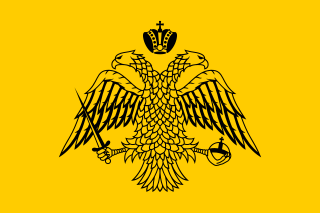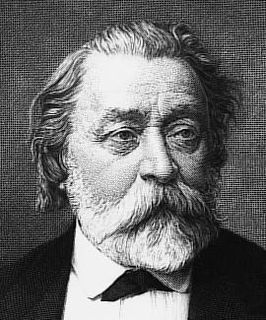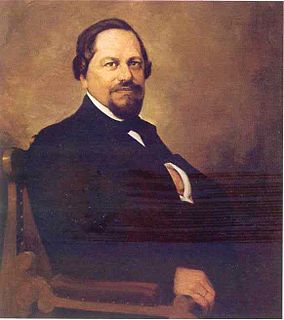
The Wiener Musikverein, commonly shortened to Musikverein, is a concert hall in the Innere Stadt borough of Vienna, Austria. It is the home of the Vienna Philharmonic orchestra.

The Romanian Orthodox Church is an autocephalous Orthodox Church in full communion with other Eastern Orthodox Christian Churches, one of the nine Patriarchates in the Eastern Orthodox Church. Since 1925, the Church's Primate bears the title of Patriarch. Its jurisdiction covers the territories of Romania and Moldova, with additional dioceses for Romanians living in nearby Serbia and Hungary, as well as for diaspora communities in Central and Western Europe, North America and Oceania.

Saint Sophia Cathedral in Kiev is an outstanding architectural monument of Kievan Rus'. The cathedral is one of the city's best known landmarks and the first heritage site in Ukraine to be inscribed on the World Heritage List along with the Kiev Cave Monastery complex. Aside from its main building, the cathedral includes an ensemble of supporting structures such as a bell tower and the House of Metropolitan. In 2011 the historic site was reassigned from the jurisdiction of the Ministry of Regional Development of Ukraine to the Ministry of Culture of Ukraine. One of the reasons for the move was that both Saint Sophia Cathedral and Kiev Pechersk Lavra are recognized by the UNESCO World Heritage Program as one complex, while in Ukraine the two were governed by different government entities.

The Timișoara Orthodox Cathedral is a Romanian Orthodox church in Timișoara, in the historical Banat region, in western Romania. The cathedral is the seat of the Archbishop of Timișoara and Metropolis of Banat. It is dedicated to the Three Holy Hierarchs, Saints Basil the Great, Gregory the Theologian, and John Chrysostom.

The Church of St George is an Early Christian red brick rotunda that is considered the oldest building in Sofia, the capital of Bulgaria. It is situated behind the Sheraton Hotel, amid remains of the ancient town of Serdica.
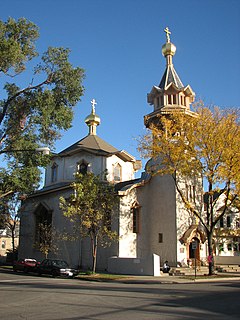
Holy Trinity Orthodox Cathedral is the cathedral church of the Orthodox Church in America Diocese of the Midwest. It is one of only two churches designed by Louis Sullivan, one of the seminal architects of the late 19th and early 20th centuries. It is listed on the US National Register of Historic Places and is designated a Chicago Landmark.
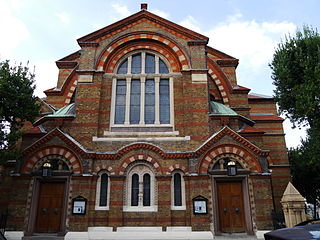
Saint Sophia Cathedral is a Greek Orthodox church on Moscow Road in the Bayswater area of London.

The Greek community in Austria numbers between 5,000 and 18,000 people. They are located all around the country but the main community is located in Vienna.

Holy Trinity Greek Orthodox Church is a historic Greek Orthodox Church building at 62 Lewis Street in Lowell, Massachusetts. Holy Trinity is one of the many Eastern Orthodox churches in Lowell, along with St. George Antiochian Orthodox Church, Transfiguration of Our Savior Greek Orthodox Church, and St. George Greek Orthodox Church. The church is under the jurisdiction of the Greek Orthodox Archdiocese of America and is locally administered by the Metropolis of Boston. The church is located the Downtown Lowell neighborhood known as The Acre. It was built in 1906 and added to the National Register of Historic Places in 1977. Holy Trinity was the first church built for a Greek Orthodox congregation in the United States. It is known for its golden dome, mosaics, iconography, and rich history.

St Andrew's Cathedral or Cathedral Church of Saint Andrew is a Greek Orthodox basilica in the west side of the city center of Patras in Greece. Along with the nearby old church of St. Andrew, it constitutes a place of pilgrimage for Christians from all over the world. It is dedicated to the First-called Apostle of Christ, Saint Andrew. Construction of the Greek Byzantine-style church began in 1908 under the supervision of the architect Anastasios Metaxas, followed by Georgios Nomikos. It was inaugurated 66 years later, in 1974. According to University of Patras professor Ch. Apostolopoulos who has extensively studied the church building, the church has a surface area of 1,900 m2 on the ground floor and additionally 700 m2 on the first level. The church has length ~60 m, width ~52 m and has a capacity of 7,000 people. Other sources give similar numbers for the size of the surface area. It is the largest church in Greece and the fourth largest Byzantine-style church in the Balkans, after the Romanian People's Salvation Cathedral in Bucharest, the Cathedral of Saint Sava in Belgrade and Alexander Nevsky Cathedral in Sofia. Over the central dome there is a 5-meter-long, gold-plated cross and over the other domes, there are 12 smaller crosses. These crosses symbolize Jesus and His apostles. The interior of the church is decorated with Byzantine-style wall paintings and mosaics.

(German: Evangelischer Friedhof Matzleinsdorf), Matzleinsdorf Evangelical Cemetery is a historic Protestant cemetery located in the Favoriten district of Vienna, the capital city of Austria.
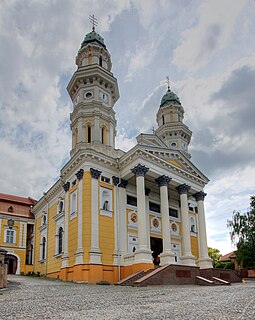
Holy Cross Cathedral is a Greek Catholic cathedral of Eparchy of Mukachevo in Uzhhorod, Ukraine. It is dedicated to the Exaltation of the Holy Cross.

Saint Nicholas Greek Orthodox Cathedral located at 419 South Dithridge Street in the Oakland neighborhood of Pittsburgh, Pennsylvania, was designed by architect Thomas Hannah and built in 1904. The First Congregational Church built the structure and used it until 1921, but it has been a Greek Orthodox Church since 1923. Currently, it is part of the Greek Orthodox Archdiocese of America, and seat of the Greek Orthodox Metropolis of Pittsburgh. This Classical Revival style church building was added to the List of Pittsburgh History and Landmarks Foundation Historic Landmarks in 1982.
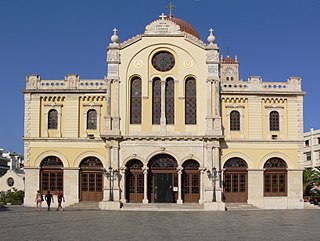
The Church of Crete is an Eastern Orthodox Church, comprising the island of Crete in Greece. The Church of Crete is semi-autonomous (self-governing) under the jurisdiction of the Ecumenical Patriarchate of Constantinople. The current Archbishop of Crete is, since 30 August 2006, Irinaios Athanasiadis.

St. Francis of Assisi Church, also known as the Emperor's Jubilee Church and the Mexico Church, is a Basilica-style Catholic church in Vienna, Austria. Built between 1898 and 1910, it was consecrated in 1913. It is located on the Mexikoplatz in Vienna's Second District, Leopoldstadt, and is administered by the Order of the Holy Trinity.
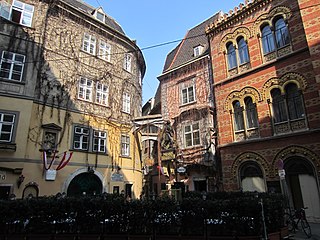
Griechenbeisl is the oldest restaurant in Vienna, Austria founded in 1447. It is located on Fleischmarkt 11 near the Holy Trinity Greek Orthodox Church.

